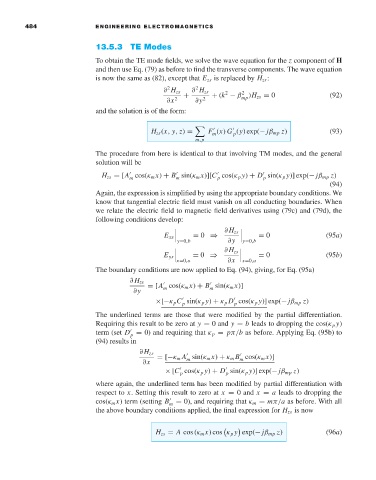Page 502 - Engineering Electromagnetics, 8th Edition
P. 502
484 ENGINEERING ELECTROMAGNETICS
13.5.3 TE Modes
To obtain the TE mode fields, we solve the wave equation for the z component of H
and then use Eq. (79) as before to find the transverse components. The wave equation
is now the same as (82), except that E zs is replaced by H zs :
2 2
∂ H zs ∂ H zs + (k − β )H zs = 0 (92)
2
2
∂x 2 + ∂y 2 mp
and the solution is of the form:
H zs (x, y, z) = F (x) G (y)exp(− jβ mp z) (93)
m
p
m,p
The procedure from here is identical to that involving TM modes, and the general
solution will be
H zs = [A cos(κ m x) + B sin(κ m x)][C cos(κ p y) + D sin(κ p y)] exp(− jβ mp z)
m
p
m
p
(94)
Again, the expression is simplified by using the appropriate boundary conditions. We
know that tangential electric field must vanish on all conducting boundaries. When
we relate the electric field to magnetic field derivatives using (79c) and (79d), the
following conditions develop:
∂ H zs = 0 (95a)
= 0 ⇒
y=0,b ∂y y=0,b
E xs
∂ H zs = 0 (95b)
= 0 ⇒
E ys ∂x
x=0,a x=0,a
The boundary conditions are now applied to Eq. (94), giving, for Eq. (95a)
∂ H zs = [A cos(κ m x) + B sin(κ m x)]
∂y m m
×[−κ p C sin(κ p y) + κ p D cos(κ p y)] exp(− jβ mp z)
p
p
The underlined terms are those that were modified by the partial differentiation.
Requiring this result to be zero at y = 0 and y = b leads to dropping the cos(κ p y)
term (set D = 0) and requiring that κ p = pπ/b as before. Applying Eq. (95b) to
p
(94) results in
∂ H zs = [−κ m A sin(κ m x) + κ m B cos(κ m x)]
∂x m m
× [C cos(κ p y) + D sin(κ p y)] exp(− jβ mp z)
p
p
where again, the underlined term has been modified by partial differentiation with
respect to x. Setting this result to zero at x = 0 and x = a leads to dropping the
cos(κ m x) term (setting B = 0), and requiring that κ m = mπ/a as before. With all
m
the above boundary conditions applied, the final expression for H zs is now
H zs = A cos (κ m x) cos κ p y exp(− jβ mp z) (96a)

